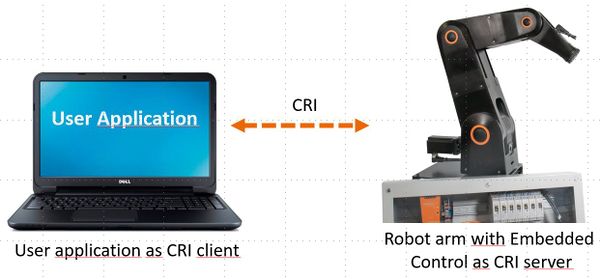Difference between revisions of "CRI Ethernet Interface"
From Wiki
| Line 10: | Line 10: | ||
==Requirements== | ==Requirements== | ||
| − | * iRC / CPRog version V902-11-011 or higher | + | * iRC / CPRog version V902-11-011 or higher |
| + | * Embedded Control with TinyCtrl version V980-11-087 or higher | ||
| + | * Updates can be found here: [[CPRog Updates]] | ||
==Documentation and Example== | ==Documentation and Example== | ||
Revision as of 10:37, 6 July 2020
The CRI ethernet interface allows remote applications to connect to a robot controller: iRC, CPRog or the embedded control.
The remote application can request the following operations:
- Jog the robot arm in joint space or cartesian space (base or tool coordinate system xyzabc)
- Send commands: joint motion, linear motion, digital outputs, ...
- Change variables
- Start and stop programs. These can be stored programs or the commands just send.
Requirements
- iRC / CPRog version V902-11-011 or higher
- Embedded Control with TinyCtrl version V980-11-087 or higher
- Updates can be found here: CPRog Updates
Documentation and Example
- Documentation: CRI Interface Documentation
- Example code CRI client: Repository with C# source code in Visual Studio Express 2019 Community Edition. The code shows how to connect, how to send the control commands and how to parse the robots answers. For a stable operation of course more means regarding e.g. fault detection and error recovery have to be taken. Do read the documentation in the link above.
CProg and iRC specific settings
The new Version of CPRog and TinyCtrl (V902-11-007 and above) allow to configure the CRI interface in the backstage menu. Press File/Interface Configuration/CRI Interface (Datei/Schnittstellenkonfiguration/CRI-Schnittstelle).
